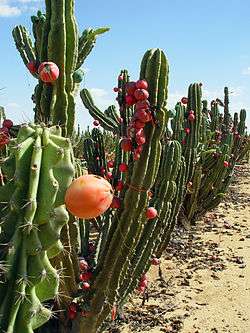Cereus (plant)
| Cereus | |
|---|---|
 | |
| Cereus peruvianus | |
| Scientific classification | |
| Kingdom: | Plantae |
| (unranked): | Angiosperms |
| (unranked): | Eudicots |
| (unranked): | Core eudicots |
| Order: | Caryophyllales |
| Family: | Cactaceae |
| Subfamily: | Cactoideae |
| Tribe: | Cereeae |
| Genus: | Cereus Mill. |
| Synonyms | |
|
Mirabella F.Ritter | |
Cereus is a genus of cacti (family Cactaceae) including around 33 species of large columnar cacti from South America. The name is derived from Greek (κηρός) and Latin words meaning "wax" or "torch". The genus Cereus was one of the first cactus genera to be described; the circumscription varies depending on the authority. The term "cereus" is also sometimes used for a ceroid cactus, any cactus with a very elongated body, including columnar growth cacti and epiphytic cacti.[1][2][3]
Description
Cereus are shrubby or treelike, often attaining great heights (C. hexagonus, C. lamprospermus, C. trigonodendron up to 15 m). Most stems are angled or distinctly ribbed, ribs 3–14, usually well developed and have large areoles, usually bearing spines. Cephalium is not present, Cereus mortensenii develops pseudocephalium. Flowers are large, funnelform, 9–30 cm long, usually white, sometimes pink, purple, rarely cream, yellow, greenish, and open at night. Fruits are globose to ovoid to oblong, 3–13 cm long, fleshy, naked, usually red but sometimes yellow, pulp white, pink or red. Seeds large, curved ovoid, glossy black.[4]
Taxonomy
The name Cereus originates in a book by Tabernaemontanus published in 1625 and refers to the candle-like form of species Cereus hexagonus. Regularly having been described by Philip Miller in 1754, and included all known cacti with very elongated bodies.[5]
_1200.jpg)
Ludwig Pfeiffer in 1838 divided Cephalocereus (type Cephalocereus senilis), the name is derived from the Greek cephale, head, thus headed cereus, referring to the hairy pseudocephalium.[6] Charles Lemaire described Pilocereus in 1839, now is renamed as Pilosocereus. The name Pilocereus is derived from the Greek pilos, felted, hairy, thus hairy cereus, similar to the Latin pilosus, from which the name Pilosocereus was derived.[7] Echinocereus (type Echinocereus viridiflorus) was described in 1848 by George Engelmann, the name is derived from the Greek echinos, hedgehog or sea urchin.[8]
Britton & Rose (1919–1923) and Alwin Berger (1929) continued to divide Cereus into many genera. The 33 or so species that remain in the Cereus group are largely plants that have not been moved out of the genus rather than plants that have been included because they fit the description of Cereus. This inclusion-by-lack-of-exclusion makes for a very messy and unsatisfactory grouping.[3]
Species
_cactus_at_Tenneti_park_04.jpg)
Anderson 2005 [9]
- Subgenus Cereus
- Cereus argentinensis
- Cereus bicolor
- Cereus braunii
- Cereus cochabambensis
- Cereus comarapanus
- Cereus fernambucensis
- Cereus fernambucensis subsp. fernambucensis
- Cereus fernambucensis subsp. sericifer
- Cereus hankeanus
- Cereus hexagonus
- Cereus hildmannianus
- Cereus hildmannianus subsp. hildmannianus
- Cereus hildmannianus subsp. uruguayanus
- Cereus insularis
- Cereus jamacaru
- Cereus jamacaru subsp. jamacaru
- Cereus jamacaru subsp. calcirupicola
- Cereus jamacaru subsp. goiasensis
- Cereus lamprospermus
- Cereus lamprospermus subsp. lamprospermus
- Cereus lamprospermus subsp. colosseus
- Cereus lanosus
- Cereus pachyrhizus
- Cereus pierre-braunianus
- Cereus roseiflorus
- Cereus stenogonus
- Cereus tacuaralensis
- Cereus trigonodendron
- Cereus validus
- Cereus vargasianus
- Subgenus Ebneria (Backeb.) D.R.Hunt
- Cereus adelmarii
- Cereus aethiops
- Cereus estevesii
- Cereus haageanus
- Cereus kroenleinii
- Cereus phatnospermus
- Cereus saddianus
- Cereus spegazzinii
- Subgenus Mirabella (F.Ritter) N.P.Taylor
- Cereus albicaulis
- Cereus mirabella
- Subgenus Oblongicarpi (Croizat) D.R.Hunt & N.P.Taylor
- Cereus fricii
- Cereus horrispinus
- Cereus huilunchu
- Cereus mortensenii
- Cereus repandus
Distribution
The range includes Brazil, northern Argentina, Paraguay, Uruguay, Bolivia, rarely Peru, Colombia, Guyana, Suriname and Venezuela.[4]
Uses
Fruits and stems of Cereus repandus are edible. Its wood has been used in making furniture and for firewood, and sliced stems have been used as a soap substitute. It is cultivated as a living fence also.[10]
Gallery
-

Charles Lemair, Iconographie descriptive des cactées, 1841 – 7.
-

Cereus uruguayanus in shrumbs formation, Uruguay
-
High plants of Cereus jamacaru.
-

Stems are segmented annually.
-

Cereus forbesii.
-

Nocturnal flowers Cereus jamacaru.
-

Fruits in cultivation.
-

Edible fruits Cereus repandus.
-
Different forms of monstrose forms.
-

Often in cultivation: Cereus peruvianus f. monstrosa.
-
_1200.jpg)
Flower bud of Cereus neotetragonus
References
- ↑ http://www.thefreedictionary.com/cereus
- ↑ http://www.merriamwebster.com/dictionary/cereus[]
- 1 2 http://cactiguide.com/article/?article=article22.php
- 1 2 Anderson, Edward F.: The Cactus Family, Timber Press, Oregon, 2001. ISBN 0-88192-498-9, pp=142-150
- ↑ Anderson, Edward F.: The Cactus Family, Timber Press, Oregon, 2001. ISBN 0-88192-498-9, p=142
- ↑ Anderson, Edward F.: The Cactus Family, Timber Press, Oregon, 2001. ISBN 0-88192-498-9, p=139
- ↑ Anderson, Edward F.: The Cactus Family, Timber Press, Oregon, 2001. ISBN 0-88192-498-9, pp=574-575
- ↑ Anderson, Edward F.: The Cactus Family, Timber Press, Oregon, 2001. ISBN 0-88192-498-9, p=230
- ↑ Edward F. Anderson (2005) (in German), Das große Kakteen-Lexikon, Urs Eggli (trans.), Stuttgart: Eugen Ulmer KG, pp. 102–112, ISBN 3-8001-4573-1
- ↑ Anderson, Edward F.: The Cactus Family, Timber Press, Oregon, 2001. ISBN 0-88192-498-9,pp=59, 69–70
Literature
- Anderson, Edward F. (2001). The Cactus Family. Oregon: Timber Press. ISBN 0-88192-498-9.